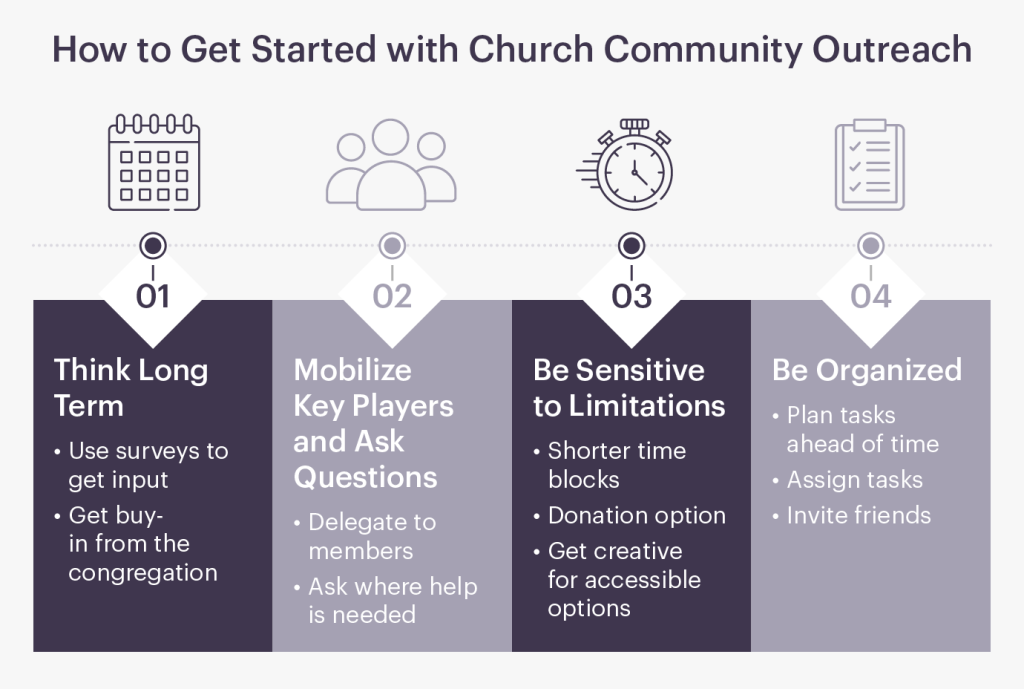Outreach Ministry efforts are an amazing way to get out of the church and serve within your community, while at the same time deepening the relationship between congregants and the church. According to pastor and author Carey Nieuwhof, “Engagement Is the New Attendance,” as referenced in the eponymous article in Christianity Today. Rather than solely focusing on how many people attended Sunday services, think in terms of how many people were engaged in a church-related activity this week.
Taking Action in Your Church’s Community
A healthy, thriving congregation typically has an active set of engaging activities that are held within the church’s own community. Think multiple small groups, popular youth groups, speaker series, bible studies, and even sports teams. But a thriving congregation is also focused on the health of its external community. What of the destitute encampment just down the road a few blocks? Or the folks lining up for an evening meal and a shower up just up the road at the community center?
“What good is it, my brothers and sisters, if someone claims to have faith but has no deeds? Can such faith save them? Suppose a brother or a sister is without clothes and daily food. If one of you says to them, “Go in peace; keep warm and well fed,” but does nothing about their physical needs, what good is it? In the same way, faith by itself, if it is not accompanied by action, is dead.” – James 2: 14-17

Think Long Term for Successful Community Outreach
When you are considering what your church community outreach efforts will look like, make sure that your mindset is long-term, not short-term. Admittedly, holding a one-off fundraiser, or volunteering one Saturday for a few hours can be rewarding, but it is typically not fulfilling in the way that a long-term commitment will be.
Also, make sure that you have significant buy-in from the congregation when selecting the programs you are going to support. You can do this by sending out a survey or hosting brainstorming sessions inquiring about the types of programs church members wish to support.
With a continuing dedication to a program, your congregation will have front row seats to the progress made with the group whom you are serving. A spokesperson can report back to the congregation with respect to successes and challenges. Consider programs that will allow parishioners of all ages to participate.
Mobilize Key Players and Ask Questions
As you consider your options, it’s important to have some key players in mind. Undeniably, church staff are almost universally overburdened, so if possible, delegate to church members to take the lead. Look to congregants who may already have tendrils into an organization or particular topic of interest.
For example, if homelessness has emerged as an area of interest for church community outreach, speak to first responders within your church. They will know the organizations most in need of community support. Significantly, they will also know which ones are most open to partnerships. Recruit leaders with the kind of personality that acts as a magnet for others. With the right key players in place, their enthusiasm will be infectious, enhancing chances for success.
We were recently so inspired by the work of one of our customers that we featured her in a Customer Spotlight. Her church, Spout Springs Church in North Carolina, wanted to become more engaged in aiding their local community. They realized that one of their nearby elementary schools had a very high percentage (90+%) of free and reduced lunch students…an indicator of local income families.
So what did Spout Spring Church do? They made an appointment with the school principal and asked how they could help. They started with a backpacks and school supplies program that has blossomed into additional aid to the school. In addition, the program has expanded into other area schools. And the best part? Everyone in the congregation is able to participate at some level.
Be Sensitive to How Busy People Are and Possible Physical Limitations
Once you’ve established what your church community outreach programs are, it’s time to get organized. After you’ve generated interest at a brunch, lunch, or meeting, one of the best ways to encourage participation is to create time blocks for volunteering. Certainly, many people have social and family obligations on weekends, and cannot commit an entire day to an outreach event. Creating two-hour time blocks allows people to dedicate time to volunteering in a way that fits into their schedule. Additionally, this increases the likelihood of broad participation.
For those who haven’t the time nor the physical capacity, you can add a donation option to your volunteer signup. This allows congregants to support your outreach efforts, even when they have time constraints. In addition, consider alternative projects that will allow those with limited funds AND limited physical ability to contribute.
Obviously, a senior citizen on a limited budget may not be able to stand for two hours serving meals at the shelter, nor afford to make a donation. Put your creative hat on! Can the seniors knit or crochet? Ask them to craft warm neck scarves for the winter. Can they can fruits or vegetables or make jam with the aid of younger parishioners? Make a day of it!

Be Organized: How to Organize Your Church’s Community Outreach Events
To ensure your outreach volunteering events run smoothly, you can assign specific tasks within each time spot. There are few things more annoying than showing up to donate time out of your busy schedule, only to find that you are either not actually needed, or the organizer hasn’t figured out where to place you.
Organizing these tasks upfront ensures that your volunteers will be prepared upon arrival, saving time on the day of the event. This creates a more positive experience for volunteers, encouraging repeat participation.
And finally, make sure your church members know that they can sign friends up for volunteering via the church community outreach programs as well. This is a non-threatening way for non-members to work shoulder-to-shoulder with your church community. We discuss this further here. They will have a first-hand view of how your church is walking the talk of helping thy neighbor.
Looking for some example signups and activities? We share some with you in this Builiding Church Community post.
Final Thought for the Reluctant Volunteers
According to the Mayo Clinic, volunteering eases mental health issues (anxiety, depression, and stress), as well as reduces the risk for physical health issues such as heart disease and stroke. So if a parishioner needs a little pick-me-up, recommend they start volunteering!
For more tips on how to organize your church’s Outreach Ministry, check out the episode, Simplifying Your Outreach Ministry Events, below!
Bonus tip: You can easily download previous volunteers’ contact information using PlanHero. When you plan future events, you can use this information to invite past participants to volunteer again, helping your ministry build a solid group of volunteers and potentially expanding your congregation.
Have you organized church community outreach ministries? Tell us about what has worked well and what has not in the comments section below!
Ready to get started planning your outreach events for your church, nonprofit, or company? Get started today!
PS – No obligation, no contract, and no credit card required to get started.


